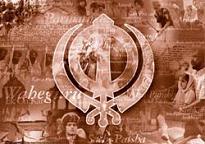
 |
Sikh Missionary Society
U.K. (Regd)
10,
Featherstone Road.
Southall, Middx, U.K. UB2 5AA
Tel: +44
020 8574
1902
Fax: +44
020 8574
1912
Reg
Charity No: 262404
|
||
|---|---|---|---|
|
|
|||
Important Sacred Sikh Shrines
Sikh Art & Architecture
Sri Darbar Sahib
The Five Takhats
The Akal Takhat
Takhat Sri Patna Sahib
Takhat Sri Kesh-Garh Sahib
Takhat Sri Damdama Sahib
Takhat Sri Hazoor Sahib
Photographs of some Historical Gurdwaras
Sikh art and architecture are an exciting fusion of some of the best features of Hindu and Muslim Art and architecture in India. Some of the famous names associated with the Sikh School of Art, in the past, are S. Kehar Singh, Bhai Kishan Singh, Bhai Bishan Singh, Bibi Amrita Shergill, S. Thakar Singh, Bhai Gian Singh, S. Sobha Singh and S. Kirpal Singh and a number of other present day artists, which followed them.
Sikh art and architecture originated and flourished in the first half of the 19th century and may be attributed to Maharaja Ranjit Singh’s rule in Panjab (1797-1839). Many features of this period were highlighted at a recent ‘Arts of the Sikh Kingdom’ exhibition at the Victoria and Albert Museum London to mark the Tercentenary celebration of the Khalsa in 1999.
A fine example of Sikh art and architecture can be found in the decorative panelling of the Harmander Sahib (Golden Temple) in Amritsar. Similarly, many paintings belonging to this period may be found in the central Sikh Museum, which is situated within the Harmander Sahib complex. Most of the oil and fresco paintings depict events and scenes from the Sikh history.
The design and decor of the Harmander Sahib are outstanding examples of both Sikh art and architecture. As well as the frescoes, Sikh craftsmen have really excelled in presenting, on the walls of the Harmander Sahib, a rare harmony of brass and gilded copper studded with small pieces of precious stones. In the words of a visiting connoisseur Mr P Brown, “Among its typical features are a multiplicity of kiosks which ornament the parapets, angles, and every prominence and projection, the invariable use of the fluted dome generally covered with copper gilded with gold or brass... no one can fail to be attracted by their animated and picturesque appearance.”
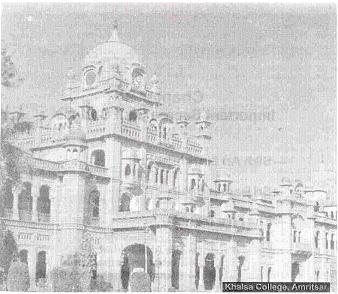
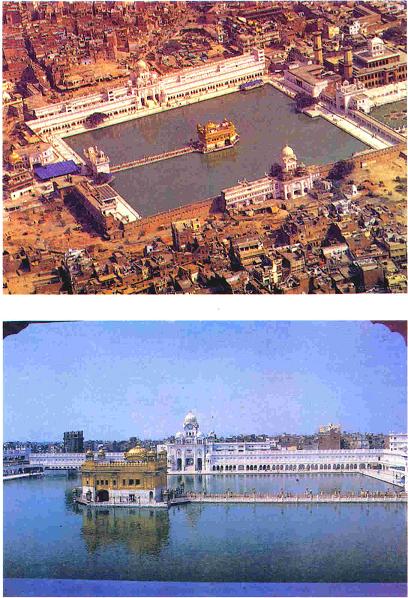
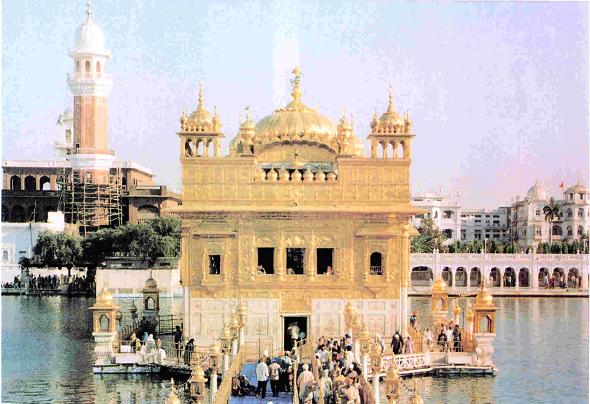
History & Significance
The idea of a central place for Sikhs to congregate for the purpose of religious guidance and spiritual uplift was first mooted by Guru Amardas. In 1573, he asked his trusted devotee Ramdas to develop an area of low-lying marshland, which is believed to have been donated by the generous Mughal Emperor Akbar. In 1577, Guru Ramdas also bought another five hundred ‘Bighas’ (about 100 acres) of the adjoining land from the landlords of Tung. He started with the excavation of a pond in the middle of the marshland. In the mean time a small settlement, which had grown near it, came to be known as Chak-Ramdaspura. This was to be the beginning of the city of Amritsar (Amrit means elixir and sar means pool). However, it was for Guru Arjan to give shape to the thought and vision of his predecessors by commissioning the construction of Harmander in the middle of this small lake named Ramdas Srover, which he had developed further.
In 1589, Guru Arjan invited his friend Mian Meer, a Muslim divine, to lay the foundation brick of the building of Harmander, which was to become the spiritual centre of the Sikhs. In 1604, the construction was complete and the Aad Granth (Sikh scripture) was ceremoniously installed there in. This soon became not only the holiest shrine of the Sikhs, but also a major rallying point in conjunction with the Akal Takhat, important adjacent building which was built, some ten years later by Guru Hargobind. As the community of Sikh worshippers increased around the Harmander, so did the number of small businesses and traders to service the growing colony, which eventually became known as the city of Amritsar.
But, unfortunately, the popularity of Harmander and the growing strength of the Sikh congregations, especially on the occasions of Vaisakhi and Diwali generated new fears among the Mughal administrators of Panjab. In particular, Zakaria Khan, the Muslim Governor of Lahore, was well known for his bigotry and intolerance towards the Sikhs. In 1738, the Gurdwara was occupied, desecrated, and the Srovar filled up. The head granthi Bhai Mani Singh was arrested and tortured to death. During the next twenty-five years or so the Harmander was the target of Afgan ruler, Ahmed Shah Abdali, on at least three occasions. In 1762, in the hope of finishing the Sikhs, once and for all, he struck at the Harmander, blew it up with gunpowder and filled up the holy Srovar with the debris of destroyed buildings and the bodies of killed Sikhs.
As mentioned previously, in 1984, the whole of the Golden Temple complex again sadly became the target; this time of the of Indian Army artillery, resulting in damage to the Harmander, desecration of the holy Srovar and a total destruction of the Akal Takhat building. However, each attempt to punish or annihilate the Sikhs, to desecrate or demolish their holiest shrine seems to have succeeded only in increasing the strength of the Sikh community and enhancing the splendour and glory of the two buildings.
By the 300th anniversary of the Khalsa Panth (in
1999) the whole of the ‘Golden Temple’ building had been re-gilded
afresh, looking more attractive than ever before. The building itself
is a two story marble construction, standing on a platform in the
middle of the sacred pool. The central structure, which has a door on
each side, symbolic of Sikh openness, welcoming people from all
directions irrespective of their caste, creed or colour. A 200 feet
long marble causeway on the western side of the pool leads to the
Harmander. A wide promenade called the Parkarma runs
around the pool perimeter. Further beyond, surrounding the ‘parkarma’
are rows of Verandas’ and rest rooms for visitors as well as for the
officials and volunteers looking after the complex.
1. Sri Akal Takhat Sahib, Amritsar
2. Takhat Sri Patna Sahib, Patna
3. Takhat Sri Kesgarh Sahib, Anandpur
4. Takhat Sri Hazoor Sahib, Nander
5. Takhat Sri Damdama Sahib, Talwandi Sabo
Literally, Akal means ‘eternal’, without time, without death or immortal. Therefore, the name Akal Takhat means the ‘Eternal Throne’ or the ‘Throne Divine’. Soon after the persecution and execution of the fifth Guru, Guru Arjan by the Mughal Governor of Lahore, the idea of creating an institution such as the Akal Takhat was conceived by the Sixth Guru Hargobind, and the first building was completed in 1609. The tragic death of Guru Arjan had convinced Guru Hargobind that, apart from having a spiritual centre in Harmander, the Sikhs also needed a place where they could gather, discuss and decide about matters regarding the general welfare of the Sikh community. However, this place had to be independent of any outside influence, always remaining within the sphere of Gurmat (Guru’s precepts), upholding truth in the deliverance of justice.
In the beginning, Guru Hargobind himself held court at the Akal Takhat. During the 18th century when the Sikhs were often the target of the Mughal Governors’ repression they used to have special gatherings and Gurmatas (discussions or resolutions) at the Akal Takhat, which was their only major rallying point. Even in the 20th century most of the political agitations by the Akalis (Sikh activists of a particular political party) were directed from here. It was here in 1984, that a bloody battle was fought between Sant Bhinderawala’s militia and the Indian Army, in which the army succeeded in its mission only after destroying the building with cannon fire. (This military action proved to be the biggest mistake on the part of the Indian Government, which snowballed into the assassination of the then prime minister Indira Gandhi and in turn into a senseless communal massacre of thousands of innocent Sikhs in Delhi and in other cities.)
The importance of the Akal Takhat to the Sikh community must not be under estimated. Traditionally, it has been the real ‘home’ or the resting place of the most sacred and original copy of the Guru Granth Sahib. It is from here that every day early in the morning, the Guru Granth Sahib is carried in a golden ‘Paalkee’ (palanquin) to the Harmander for the daily Darshan (sight) of the devotees, and then carried back to the Akal Takhat’s care late in the evening. This defines the responsibility of the Akal Takhat as the guardian or custodian of the Sikh faith, and the protector of the holiest Sikh shrine, Harmander.
Today, the Akal Takhat is regarded as the highest authority or the ‘supreme court’ of the Sikhs. It is here that important ‘Gurmatas’ regarding the Sikhs and Sikhism are made jointly by the five Jathedars (leaders) of the five Takhats in the presence of the assembled Khalsa. It is from here that the Jathedar of the Akal Takhat makes his pronouncements (Hukamnama), and issues directives or guidelines on matters of extreme importance to the Sikhs, which are regarded as binding for the whole Sikh nation. Thus, to the Sikhs the importance of the Akal Takhat is more of a temporal nature whereas that of the ‘Golden Temple’ is purely spiritual. It is for this reason that the Akal Takhat is the shrine where two huge flagpoles stand side-by-side, one bearing the flag of ‘MEEREE’ (temporal authority) and the other flag of ‘PEEREE’ (spiritual authority).
Sri Akal Takhat Sahib, Amritsar
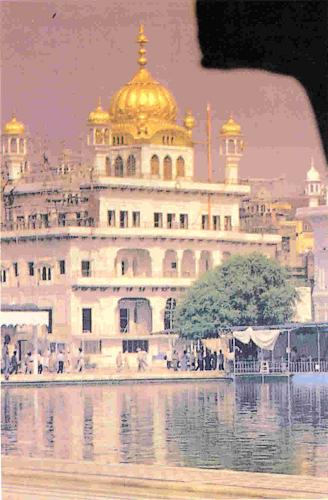
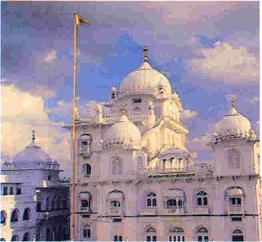
This Takhat is situated in the middle of the old part of the city of Patna, called ‘Patna Sahib’ by Sikhs out of religious reverence. Patna city, situated on the Ganges river, is also the capital of the eastern Indian state of Bihar and is about two thirds of the way from Delhi to Calcutta. The Sikh shrine of Patna Sahib was originally a haveli (mansion) where Guru Gobind Singh was born on 22nd December 1666. Later, sometime in the 18th century, a new building called ‘Hari Mandir’ was constructed at the sight, which became an important centre of Sikh pilgrimage. However, because of an accidental fire, the building was reconstructed in 1839 under the patronage of Maharaja Ranjit Singh. Unfortunately in 1934, this building was again damaged by an earthquake. The construction of the present four-storied magnificent marble building started in 1954 and was completed by 1960.
As well as the usual Guru-Ka-Langar
and the visitors rest rooms the management of the Takhat runs a free
homeopathic dispensary for the poor and needy, two separate high
schools for boys and girls, and a degree college named after Guru
Gobind Singh. Some artefacts belonging to Guru Gobind Singh are also
preserved in the shrine, which are very much revered by the visiting
devotees.
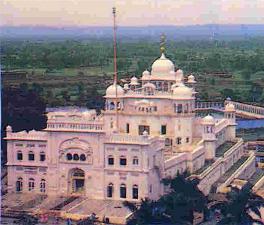
This Takhat is located on a hillock at the town of
Anandpur, which is about 80 kilometres northwest of Chandigarh, the
capital city of the Panjab state. Although there are some other
important historical Gurdwaras in the area, and throughout Panjab, the
significance of Sri Keshgarh Sahib and indeed of the town of Anandpur
as a centre of the Sikh pilgrimage is only second to that of Amritsar.
This is mainly because of the fact that this historic Gurdwara has been
built at the site where the momentous ceremony of the formal
inauguration of the Khalsa Panth took place in 1699.
The shrine constitutes a magnificent building, which was re-constructed
in the middle of the 20th century, with the usual complementary
buildings for the provision of Langar, and pilgrim’s rest rooms, which
were added later. The proximity of Anandpur Sahib to the lower spurs of
the Himalayas on one side and the river Satluj on the other, together
with surrounding picturesque scenery makes it one of the most beautiful
places in Panjab. Only 20 kilometres further north is another popular
tourist landmark called Bhakra dam, one of the highest dams in the
world. In the month of March the Hola Mohalla celebrations
at
Anandpur
are particularly popular with Sikh pilgrims.
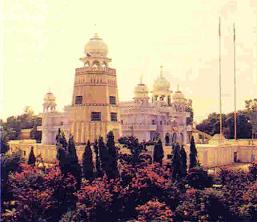
‘Dam’ pronounced as ‘dum’ literally means breath,
and the name ‘Damdama Sahib’ refers to a place where the Guru had a
‘breather’ i.e. the place where he rested. It was here that Guru Gobind
Singh was able to take rest for about a year after the battles of
Chamkaur and Mukatsar. It was here that he was re-united with his wives
Mata Sundri and Mata Sahib Kaur, as well as many other poets and bards
who had been separated from him when Anandpur was besieged by the
Mughal armies. Later, during this rest period Guru Gobind Singh
reproduced another hand written copy of the original Aad Granth with
the help of Bhai Mani Singh, a contemporary Sikh scholar and scribe.
Here, more than a dozen Gurdwaras are named, after one or the other
Guru. However, the one at Talwandi Sabo, about 30 kilometres southeast
of the district town of Bathinda (Panjab) is of this particular
historical significance and has been accorded the status of a Takhat.
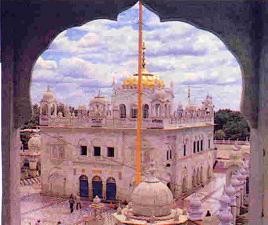
This holy shrine is also called Sach-Khand
(True Lord’s place or place of eternal rest) being associated with the
death of Guru Gobind Singh on October 7, 1708. The district town of
Nanded is situated on the banks of River Godavari, in the Indian state
of Maharashtra and is about 500 kilometres to the east of Mumbai,
formerly Bombay. It was here that before his departure the Guru
ordained that henceforth the Holy Guru Granth would be the ‘Spiritual
Guru’ of the Sikhs. The present building of the historic Gurudwara was
commissioned by Maharaja Ranjit Singh in 1832 and was completed in
1837. The architecture and design, especially the ornamental interior
of this building resembles that of the Harmander Sahib, Amritsar. Some
artefacts belonging to Guru Gobind Singh are also exhibited here.
Gurdwara Patshahi, Chhevin, Takhtupura (Faridkot)
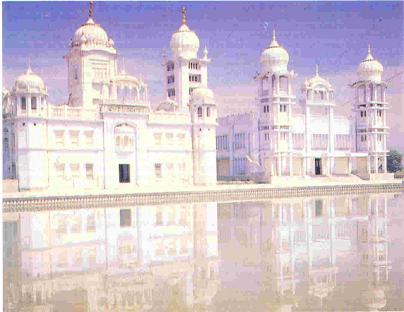
Gurdwara Dukh Niwaran Sahib, Patiala
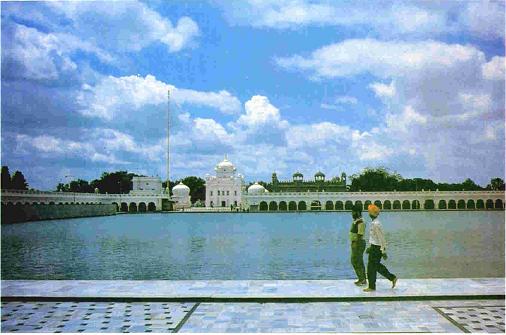
Gurdwara Bibhour Sahib, Nangal
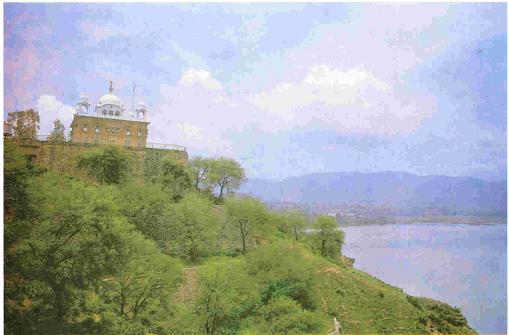
Gurdwara Budha Jour Sahib, Padampur (Rajasthan)
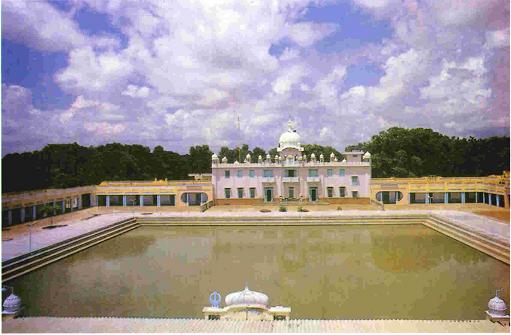
Gurdwara Bangla Sahib, Delhi
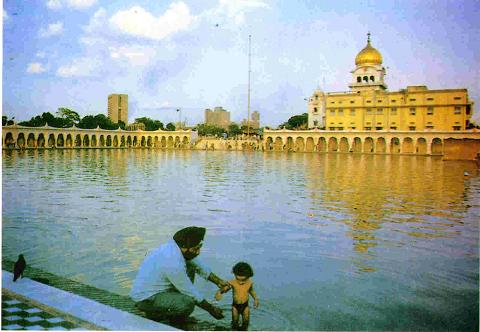
Gurdwara Lakhan Sar, Talwandi Sabo
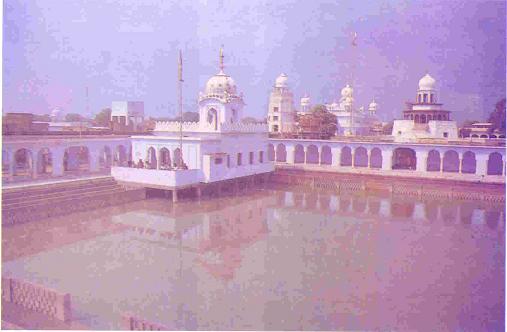
Gurdwara Patshahi Dasvi, Kote Kapura
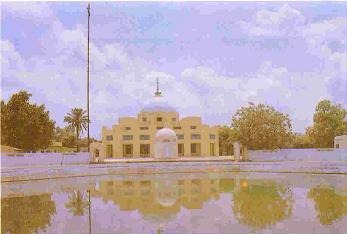
Gurdwara Beed Baba Budha Ji, Jhabal (Amritsar)
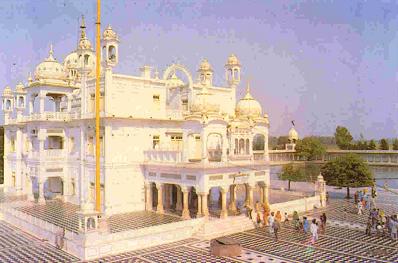
| Previous Chapter - Chapter 8 : Some other Topics |
Next Chapter - Chapter 10 : Some Stories from the life of Sikh
Gurus
|